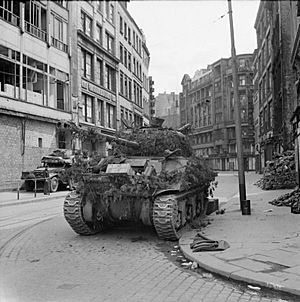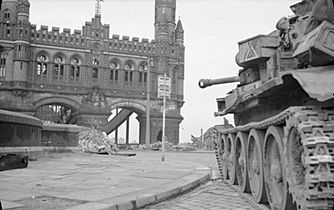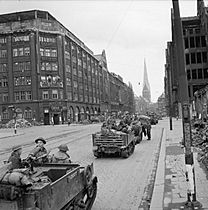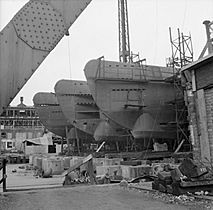Capture of Hamburg facts for kids
Quick facts for kids Capture of Hamburg |
|||||||||
|---|---|---|---|---|---|---|---|---|---|
| Part of the Western Allied invasion of Germany in the Western Front of the European theatre of World War II | |||||||||
 A British Sherman Firefly tank in the city centre after the battle. |
|||||||||
|
|||||||||
| Belligerents | |||||||||
| Commanders and leaders | |||||||||
| Miles Dempsey Evelyn Barker Lewis Lyne |
Kurt Student Alwin WolzExpression error: Unrecognized punctuation character "{".Expression error: Unrecognized punctuation character "{".Expression error: Unrecognized punctuation character "{". |
||||||||
| Units involved | |||||||||
| VIII Corps (7th Armoured Division) XII Corps (elements) |
1st Parachute Army (elements) | ||||||||
| Strength | |||||||||
| 3 divisions | 2 divisions (understrength) | ||||||||
The Capture of Hamburg was a key battle near the end of World War II. It happened between April 18 and May 3, 1945. British forces fought against German troops for control of Hamburg, Germany. Hamburg was one of the last strongholds in northern Germany. After a tough fight, the British captured the city. This allowed them to continue their advance and trap the remaining German forces in the Jutland peninsula.
Contents
Why Was Hamburg Important?
After the Allied forces crossed the Rhine River, German armies in the west began to weaken. The main German defense, called Army Group B, was surrounded and captured. This meant Germany had very little organized resistance left.
The Allied armies then pushed across Germany. The British Second Army, led by Miles Dempsey, advanced through northern Germany. Their goal was to reach Berlin. The British faced less resistance than the American forces further south. They moved quickly and steadily.
The German 1st Parachute Army and a new group called Army Group Northwest were the last German forces in the north. Even though Berlin was under attack by the Red Army, the German high command refused to send more soldiers. The Germans tried to hold Bremen for a week, but the remaining troops had to retreat. Hamburg became their last major defensive point.
The Battle for Hamburg
Getting Ready for the Attack
The British 7th Armoured Division led the attack towards Hamburg. They aimed for Harburg, a district across the River Elbe from Hamburg. Meanwhile, the 15th (Scottish) Infantry Division attacked Uelzen to the south. Other British troops from the XII Corps attacked Hamburg from the northwest.
On April 18, the 7th Division captured the towns of Welle and Tostedt. The next day, they moved into Hollenstedt. The Germans had already set up strong defenses in Harburg. By April 20, the 7th Division captured Daerstorf, about 13 kilometers (8 miles) west of the city. British artillery officers reached the Elbe River. They started directing artillery fire at German troops and trains on the other side.
On the same day, the British 131st Infantry Brigade took Vahrendorf, just two miles south of Harburg. The 7th Division then paused its advance for five days. They set up defenses and prepared for the main assault on Hamburg.
German Counter-Attack
On April 26, German forces tried to push back the British at Vahrendorf. This group included the 12th SS Reinforcement Regiment, Hitler Youth members, sailors, and police. They used powerful 88 mm and 75 mm guns. They even reached the center of Vahrendorf. However, British tanks arrived and forced them back. The fighting continued until the next day. The Germans then retreated to Harburg, leaving behind 60 dead soldiers and 70 prisoners.
Entering the City
The British began their main attack on Hamburg on April 28. The 5th Royal Tank Regiment, 9th Durham Light Infantry, and 1st Rifle Brigade captured Jesteburg and Hittfeld. These towns were important because of the autobahn (highway) there. However, the Germans blew up parts of the autobahn at Hittfeld, which slowed the British advance.
As the British moved closer, it was clear the Germans would not give up easily. The German troops were a mix of different groups. These included a few SS soldiers, paratroopers, Volkssturm (a home guard), and regular Wehrmacht soldiers. Sailors, police, firefighters, and Hitler Youth also joined the fight. They used 88 mm anti-aircraft guns for ground defense, as they were no longer needed to shoot down planes.
Many German units were still hiding in the woods south of Hamburg. These included a tank destroyer battalion and a Hungarian SS unit. Many German soldiers also had Panzerfaust anti-tank weapons. The British had bypassed this area earlier. Now, the 53rd (Welsh) Infantry Division, supported by the 1st Royal Tank Regiment, cleared the woods. They captured about 2,000 German soldiers.
On April 28, the 3rd Regiment Royal Horse Artillery started shelling the Phoenix Rubber Works in Hamburg. This led to a German group coming out with a white flag to talk about surrender. On April 29, a group from the city came to discuss surrendering. On May 1, General Alwin Wolz's car, also flying a white flag, approached the British. General Wolz and a small German group arrived at the British Division Headquarters on May 2. They formally surrendered Hamburg on May 3. That same afternoon, the 11th Hussars led the 7th Armoured Division into the damaged city.
What Happened Next?
Hamburg was the last major German defense in the north. After the British captured the city, the remaining German troops retreated into the Jutland Peninsula. Many went to Kiel. There, they met soldiers from Army Group Vistula, who were fleeing from the Soviets on the Eastern Front.
The 7th Armoured Division continued its advance without fighting to Lübeck. On May 4, news arrived about the German surrender at Lüneburg Heath. This was followed by the official German Instrument of Surrender on May 9, which ended the war in Europe.




